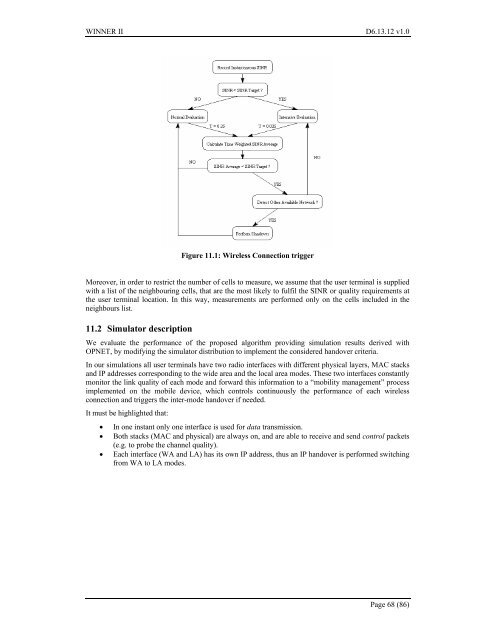IST-4-027756 WINNER II D6.13.12 v1.0 Final CG “local area ...
IST-4-027756 WINNER II D6.13.12 v1.0 Final CG “local area ...
IST-4-027756 WINNER II D6.13.12 v1.0 Final CG “local area ...
Create successful ePaper yourself
Turn your PDF publications into a flip-book with our unique Google optimized e-Paper software.
<strong>WINNER</strong> <strong>II</strong> <strong>D6.13.12</strong> <strong>v1.0</strong>Figure 11.1: Wireless Connection triggerMoreover, in order to restrict the number of cells to measure, we assume that the user terminal is suppliedwith a list of the neighbouring cells, that are the most likely to fulfil the SINR or quality requirements atthe user terminal location. In this way, measurements are performed only on the cells included in theneighbours list.11.2 Simulator descriptionWe evaluate the performance of the proposed algorithm providing simulation results derived withOPNET, by modifying the simulator distribution to implement the considered handover criteria.In our simulations all user terminals have two radio interfaces with different physical layers, MAC stacksand IP addresses corresponding to the wide <strong>area</strong> and the local <strong>area</strong> modes. These two interfaces constantlymonitor the link quality of each mode and forward this information to a “mobility management” processimplemented on the mobile device, which controls continuously the performance of each wirelessconnection and triggers the inter-mode handover if needed.It must be highlighted that:• In one instant only one interface is used for data transmission.• Both stacks (MAC and physical) are always on, and are able to receive and send control packets(e.g. to probe the channel quality).• Each interface (WA and LA) has its own IP address, thus an IP handover is performed switchingfrom WA to LA modes.Page 68 (86)
















